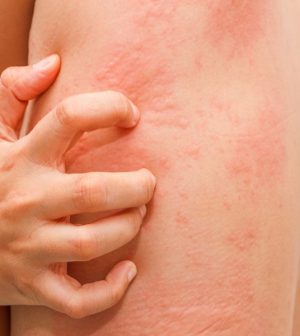- See What Saffron Can Do for Sleep and Heart Health
- 6 Common Mistakes to Avoid Before Your Physical
- Can Sweating Really Help You Beat a Cold?
- Strengthening Your Relationship: Practical Strategies
- Skip Storing This Everyday Product in the Fridge Door
- Green Tea + B3 Pairing May Boost Brain Health
- Navigating Your Midlife Crisis: Embracing New Possibilities
- City Raccoons Showing Signs of Domestication
- Mapping the Exposome: Science Broadens Focus to Environmental Disease Triggers
- One Week Less on Social Media Linked to Better Mental Health
Stress Rash: What Is It and How to Treat It

We know that stress can take a toll on the body, but many may not realize it can produce a rash.
“Stress can increase the level of the hormone cortisol, increasing inflammation in your body, which can lead to hives, acne, eczema, and hair loss, among other symptoms,” dermatologist Dr. Elizabeth Farhat said in a recent article.
Typically, hives are caused by an allergic reaction but can actually be triggered by stress. According to Scripps, you are more likely to develop a stress rash if you have experienced asthma, eczema, rosacea or allergies.
Here is everything you need to know to manage a stress rash.
What does stress rash look like?
According to the Cleveland Clinic, hives can appear on your face, hands and neck. The hives will look like raised bumps that are reddish on lighter-colored skin. They can look like tiny pinpoints or welts and may develop into raised red clusters. Hives can change size and shape. When you press on the bumps, the skin will turn lighter in the center. When you have a stress rash on your face, you may also experience painful swelling of your lips, eyes and the inside of your throat. The rash can burn, itch and cause pain.
Where does a stress rash appear?
Hives can appear anywhere on the body. However, according to Scripps, when a stress rash causes hives, they are more likely to appear on the face, neck, chest or arms. The hives can be as small as a pinpoint or merge into an area the size of a dinner plate. They can come and go within a few days, but can then return. The rash can wax and wane for up to six weeks or even years.
How to get rid of a stress rash
If you have swelling of the mouth or throat, this is considered a medical emergency. Call 911 immediately.
The Mayo Clinic recommends using non-drowsy anti-itch medications (antihistamines). They will calm the itching and reduce the swelling associated with the rash. They are available over the counter and by prescription.
Mount Sinai suggests adding an over-the-counter antacid along with the antihistamine for more robust help. The American Institute of Stress recommends trying milk compresses. The fat in whole milk can soothe skin; skim milk won’t work here. Cold compresses may also provide relief from itching and swelling. Topical steroids, like hydrocortisone, can also help.
The Mayo Clinic also recommends taking a cool bath. Adding baking soda and oatmeal to the tub can relieve the itching associated with hives. Wear loose-fitting clothing to avoid irritating the rash further.
You should seek medical assistance:
- If you experience swelling of the throat or mouth or you are experiencing wheezing.
- If the rash persists for more than six weeks
- If the discomfort is not relieved by over-the-counter medications.
The good news is that although hives can be uncomfortable, they are usually harmless and disappear on their own.
How to prevent a stress rash
The best way to prevent stress rashes is to manage your stress levels:
Thea Gallagher, a clinical assistant professor in the department of psychiatry at NYU Langone Health in New York City, gave HealthDay some tips for managing stress. They include:
- Get moving: Exercise helps your body combat stress
- Decompress daily: Incorporate mindfulness, meditation, yoga and deep breathing to relieve stress
- Get better sleep: Six to eight hours of sleep per night is ideal
- Eat a healthy diet: Incorporate fruits, vegetables, whole grains and lean protein into your meals
- Connect: Connecting with loved ones is great for stress relief
- Ask for help: See your doctor if the stress is persistent
- Keep your perspective: Focus on the good in your life.
Source: HealthDay
Copyright © 2025 HealthDay. All rights reserved.










